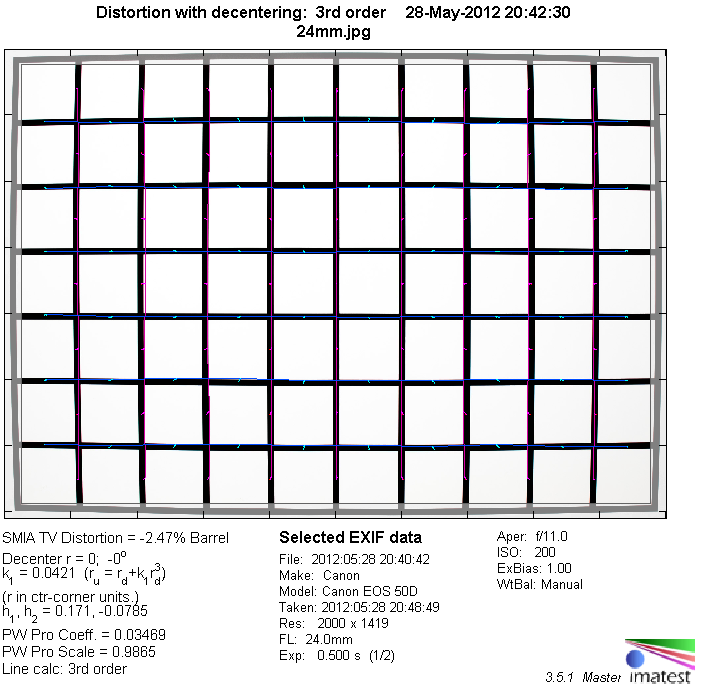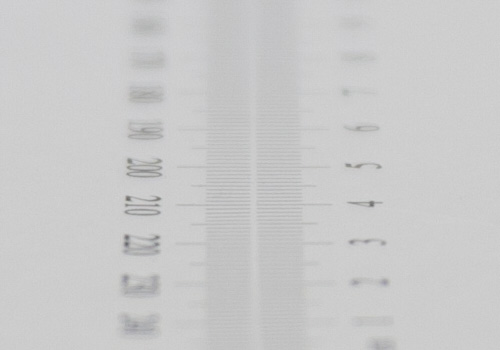|
Tamron AF 24-70mm f/2.8 SP Di USD VC (Canon EOS) - APS-C Review / Lens Test - Analysis |
|
Lens Reviews -
Canon EOS (APS-C)
|
|
Page 2 of 2

Distortion
In the APS-C scope the distortion levels are tamed down compared to the full format results. At 24 mm the lens shows a medium amount of barrel distortion (~2.5%). In the middle to upper range distortion is basically negligible.
|
Move the mouse cursor over the focal length text marks below to observe the respective distortion
|
| 24mm |
40mm |
70mm |
|

|
The chart above has a real-world size of about 120x80cm.
Vignetting
The full format Tamron lens enjoys the usual sweet spot advantage when used on an APS-C camera. This is especially valid for the vignetting. There's only a slight light falloff at max. aperture and it's absolutely irrelevant when stopping down a bit.

MTF (resolution)
The Tamron 24-70mm f/2.8 produces highly impressive resolution figures in the APS-C scope. The center performance is excellent at large to medium aperture settings and the borders and corners are very good here with only a very slight decrease in performance at 70mm at f/2.8.
Please note that the MTF results are not directly comparable across the different systems!
Below is a simplified summary of the formal findings. The chart shows line widths per picture height (LW/PH) which can be taken as a measure for sharpness.
If you want to know more about the MTF50 figures you may check out the corresponding Imatest Explanations
Chromatic Aberrations (CAs)
Chromatic aberrations (color shadows at harsh contrast transitions) well controlled and not really relevant at all tested aperture settings and focal lengths.

Bokeh
Being a fast lens it allows for good subject separation and thus the quality of out-of-focus blur is certainly of interest. We looked at bokeh with our standard test scene at 70mm focal length, which is closest to classic head to shoulder portrait lenses (~85mm).
The general quality of the background blur is quite smooth (see the left sample crop below). However, the foreground blur is more busy (to the right).
 Thanks to 9 rounded aperture blades, background highlights retain their circular shape throughout the whole aperture range. However, the inner area of the highlight disc is rather nervous - possibly a side effect of the aspherical elements. The highlight discs (in the center) remain circular even at f/5.6 so the design of the rounded aperture blades is obvious here.
Thanks to 9 rounded aperture blades, background highlights retain their circular shape throughout the whole aperture range. However, the inner area of the highlight disc is rather nervous - possibly a side effect of the aspherical elements. The highlight discs (in the center) remain circular even at f/5.6 so the design of the rounded aperture blades is obvious here.
 Note: this portion has been mostly reused from the full format review. On an APS-C DSLR the highlight rendition is somewhat better towards the borders because the "cat's eyes" effect is actually cropped away but other that there are no differences here.
Note: this portion has been mostly reused from the full format review. On an APS-C DSLR the highlight rendition is somewhat better towards the borders because the "cat's eyes" effect is actually cropped away but other that there are no differences here.
Bokeh Fringing / Longitudinal Chromatic Aberrations (LoCA)
LoCAs (non-coinciding focal planes of the various colors) are a common issue with relatively fast glass - they are often noticeable in out-of-focus halos: magenta (red + blue) in front the focus point and green beyond. Surprisingly the Tamron is only marginally affected from this flaw.
If you scroll through the images below you may notice a slight shift in focus when stopping down. This is a so-called "residual spherical aberration".
|
Move the mouse cursor over the f-stop marks below to observe the respective LoCAs
|
| f/2.8 |
f/4.0 |
f/5.6 |
|

|
Note: this portion has been mostly reused from the full format review.
VerdictThe Tamron AF 24-70mm f/2.8 SP Di USD VC already delivered very good results in the full format scope so it's not a surprise that the APS-C results are even better! The resolution characteristic is almost flawless with an excellent center from f/2.8 up to f/8 and a very good outer image region. Lateral CAs are low which contributes to the high sharpness perception. Thanks to the sweet spot behavior on APS-C, the vignetting is nothing to worry about even at f/2.8. Distortions are really only an issue at 24mm and there aren't even overly high here. The quality of the bokeh is something of a mixed bag. It is quite smooth in the background but the foreground as well as bokeh highlights can be nervous. However, bokeh fringing is not an issue to worry about.
So far we were mostly unimpressed by the build quality of Tamron lenses. However, we are happy to report that things have improved with the Tamron AF 24-70mm f/2.8 SP Di USD VC. The lens barrel is mostly made of plastics but it is of high quality and it is tightly assembled. The new weather sealing is very welcome, of course. Same goes for the very fast and silent USD (ultrasonic AF drive). Tamron's VC (Vibraction Compensation) image stabilizer is a welcome addition, of course. Based on what we have experienced during the field trip we would rate it with a 3 f-stops efficiency. Your mileage may vary here a bit into the one or the other direction depending on your shake characteristic.
So technically the Tamron AF 24-70mm f/2.8 SP Di USD VC surely deserves our "highly recommended" badge. However, remember that its zoom range isn't overly attractive on APS-C DSLRs and the lens is also substantially bigger, heavier and also more expensive than the Canon EF-S 17-55mm f/2.8 USM L IS which remains a more obvious choice here in our opinion. The Tamron lens is really more geared towards its native full format scope. If you don't mind all this you will get a great piece of equipment though!
|